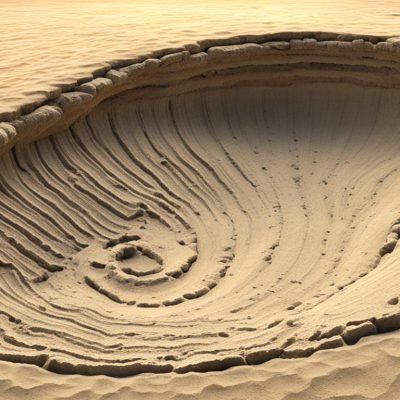Fossil discoveries are key in paleontology, letting us look into Earth’s ancient past. They show evidence of past life and teach us about the history of plants and animals. Thanks to early observers like Xenophanes and Steno, we’ve learned a lot about prehistoric times.
Study of ancient fossils shares amazing details about life before us. They reveal how species lived together and how ancient beings grew. This helps us understand how Earth and its life forms have changed over many years.
Key Takeaways:
- Fossil finds greatly help us grasp Earth’s history.
- They present proof of past life and the variety of early life forms.
- Fossils offer insights into how ancient creatures lived and grew.
- Learning from fossils is a vital part of understanding evolution and extinction.
- New fossil discoveries keep adding to our ancient story.
Early Fossil Discoveries: Traces of Ancient Life
Early fossil finds by thinkers and scientists were crucial in understanding past life. Explorations then helped explain the Earth’s ancient creatures. Xenophanes, Shen Kuo, and Nicholas Steno particularly stand out for their work. They challenged old ideas and pushed for new scientific questions.
Xenophanes, an ancient Greek philosopher, found fossilized shells around 570-475 BCE. He knew they showed life from a long time ago. Xenophanes’ discovery was a key step in showing there was life different to ours before.
Shen Kuo, a multi-talented person in China from 960 to 1279 CE, found ancient marine fossils. These fossils were found in rocks far from the sea today. His discovery changed what people thought about the Earth’s history and showed it keeps changing.
Nicholas Steno lived in the 17th century and is known as the first to study the Earth’s layers. He noticed that shark teeth looked like some rocks they had found. These rocks were thought to have magical powers but turned out to be fossils. Steno’s find was solid proof of ancient life.
These trailblazers set the path for the science of paleontology. They proved how fossils are key for learning about the Earth’s past species. Their work challenged old ideas and encouraged more study of our planet’s history.
The Remarkable Mary Anning

Mary Anning was an English paleontologist born in 1799. She overcame many obstacles to do important work in paleontology. Even though the 19th century scientific world was mostly for men, Anning made a big impact.
Her key find was several complete ichthyosaur skeletons. These were marine reptiles from a long time ago. Anning carefully dug these up and studied them. Her work shed light on how these ancient sea creatures looked and behaved.
Anning’s efforts in paleontology are still admired today. She showed the value of early fossil finds. Her work is a lasting tribute to how fossils teach us about the Earth’s past.
Fossils as Clues to Past Environments and Behaviors
Fossils are more than just old bones. They tell us about life in ancient times. Fossils show us how creatures acted and lived in their environments.
For example, leaf fossils with bite marks resemble today’s caterpillar damage. This hints at ancient ecosystems. It shows us plants and insects interacted long ago.
Leaf fossils show damage patterns similar to those caused by modern caterpillars, suggesting the presence of ancient insect species. This gives us a glimpse into the ecological relationships between plants and insects in prehistoric times.
Looking at fossils also reveals how ancient creatures grew. The skull of the dome-headed Stegoceras validum has a unique shape. Scientists think this skull shape was for protection or showing off.
The unique skull shape could hint at old fighting or display habits. So, fossils are key to understanding behavior from long ago.
Through fossils, we learn about ancient worlds and creatures. They are a time machine into the past. Fossils show a rich, interconnected history of life on Earth.
The Dome-Headed Dinosaur: Stegoceras validum

Key Takeaways
- Fossils reveal insights into ecological relationships and behaviors of prehistoric life.
- Leaf fossils can show damage patterns similar to those caused by modern caterpillars, indicating the presence of certain species in ancient environments.
- Fossils of the dome-headed dinosaur Stegoceras validum’s skull provide evidence of growth patterns and possible prehistoric behaviors.
- Studying fossils helps reconstruct ancient environments and behaviors, shedding light on the past.
Types of Fossils: From Hardened Remains to Impressions
Fossils come in many forms, all with unique stories to tell about the ancient Earth. Paleontologists have found different kinds of fossils. Let’s check out what stories they share with us.
Mold Fossils
A mold fossil forms when sediment hardens around an organism’s shape. This happens as the organism decays, leaving a perfect hollow in the rock. We learn about past creatures’ size and shapes from these fossils.
Cast Fossils
Cast fossils occur when a mold gets filled with minerals or sediment, making a copy of the organism. This gives a 3D view of the ancient being. Scientists can closely examine its form because of this process.
Petrified Wood
Petrified wood is made when a tree gets covered in sediment. Its cells are replaced by minerals over time, turning it into stone. This process keeps the tree’s original shape while changing it into solid rock.
Carbon Films
Carbon films are a unique way of preserving fossils. They’re thin layers of carbon-rich material left behind when plants or animals decay. These films show the soft tissues and physical features of ancient life.
Trace Fossils
Trace fossils are not the body of an ancient creature but signs of their activity. This includes footprints, burrows, and nests. They tell us how these creatures moved and lived long ago.
Studying fossils helps scientists uncover Earth’s history. They tell us about species that are now extinct. We learn about the environments they lived in and the changes Earth has gone through over millions of years.
| Fossil Type | Description |
|---|---|
| Mold Fossils | Fossils formed when an organism’s shape is preserved in sediment. |
| Cast Fossils | Replicas of organisms formed by filling the hollow spaces of mold fossils with minerals or sediment. |
| Petrified Wood | Fallen trees covered with sediments that later turn into stone, preserving the tree’s shape. |
| Carbon Films | Thin films of carbon residue preserved in sedimentary rock, providing details of ancient organisms’ soft tissue. |
| Trace Fossils | Imprints or evidence of an organism’s presence or activity, such as footprints and burrows. |
Image Source: seowriting.ai
Conclusion
Fossil discoveries keep showing us more about our planet’s ancient history. These findings offer key insights into the life of long ago, revealing how things have evolved over time. By looking at fossils, scientists learn about the complex story of life on Earth. This helps us understand the nature around us better.
Scientists are always finding more fossils. This ongoing work challenges what we thought we knew and adds to our knowledge. Fossils aren’t just bones; they also show us how ancient animals and plants lived and interacted. They give us a look at places that no longer exist, and creatures that have disappeared.
Every new find adds a piece to the puzzle. It helps us to understand our past. Fossils let us touch the ancient world, sparking our interest in the past. By studying them, we learn more about the variety of life over the years, and the changes it has gone through.



